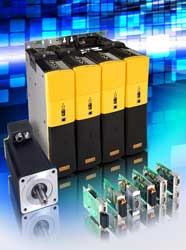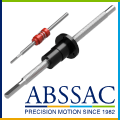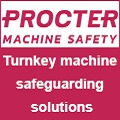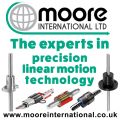
Posted to News on 30th Jul 2008, 12:02
Motion control breakthrough: higher performance, lower costs
This article by Baldor explains the benefits available to machine builders now that they can source all of the hardware and software necessary for machine control - including motion control - from a single supplier.

The availability of a comprehensive range of motion control components compatible with the real-time Ethernet Powerlink (EPL) protocol is presenting significant design opportunities for machinery OEMs. Baldor now offers all the major motion control functions, including Ethernet Powerlink three-phase AC drives, single-phase drives, a motion and machine controller, and development tools. Together, this range provides machine builders with an exceptionally versatile control platform that can improve performance substantially, while simultaneously simplifying the control architecture and reducing costs.
David Greensmith of Baldor comments: "The technical benefits of a high-speed machine network have been well publicised, but it is the simple factors of product availability and system cost savings that are being overlooked. Machine builders are definitely sold on the system building benefits of the architecture. For each drive node, I calculate that a single Ethernet CAT5e cable eliminates somewhere in the region of 40 to 50 cable stripping, soldering and assembly tasks, for example. Ethernet now accounts for the majority of our sales enquiries, and the completion of the product range with three-phase drives opens the technology to most machinery OEMs."
Significant savings
From its first 18 months' experience with Ethernet motion, Baldor has proved the technology to be very attractive in small to medium multi-axis systems arena. The savings come mainly in the area of simpler engineering, and reduced control hardware, cabling and assembly. Even though the actual cost of the Ethernet elements is a few per cent higher than traditional motion equipment, the overall savings can be significant.
The recent introduction of three-phase AC drives means that users can build all-Ethernet systems with the optimum choice of motor technology for each axis, from small to large loads. Rotary and linear versions of brushless servo and AC vector motors are all software-selectable.
Many machine builders are trying to move to all-electronic architectures to provide software-centric, highly-reconfigurable equipment. Baldor's Ethernet technology is particularly beneficial for this, as its single controller can manage up to 200 different machine control components such as I/O, absolute encoders, Ethernet PowerLink DS402 positioning drives and stepper motors, as well as up to 16 interpolated axes. As one example of the potential of this control, machine builders could replace pneumatic actuators with stepper or servo motors, for instance, with no increase in controller hardware "" thereby eliminating the costs and issues associated with maintaining a secondary supply of clean compressed air.
Unlike traditional motion networks, the Ethernet network does not force a machine builder to adopt any particular control architecture. Systems can still have a central controller if preferred "" co-ordinating all drives in profiled torque, speed or position modes. However, these axes can also be self-controlled positioning devices (DS402-compatible positioning drives) that respond on command and consume little central processing overhead. In addition, intelligent (programmable) drives can be employed in a system to implement more complex standalone axes, or to implement the complete motion system. Powerlink lends itself very well to all these scenarios, with the same network manager controlling any type of architecture, or mix.
The sheer bandwidth of the 100 Mbits/s Ethernet network also simplifies machine building because it merges the functionality of a fieldbus and a motion bus into one system. Functionality normally reserved for the device service port "" such as firmware updates, configuration and diagnostics "" can all be communicated via that common network. This powerful new capability is typically dubbed 'total network visibility.'
Powerlink and TCP/IP protocols
Applications can be implemented using two flavours of Ethernet. The Ethernet Powerlink protocol provides deterministic real-time performance that makes it suitable for handling the most demanding motion control tasks, as well as a means to link seamlessly with standard Ethernet networks. An alternative is the use of standard TCP/IP protocols, which can be suitable if the automation in question does not have any demanding time synchronisation or multi-axis co-ordination considerations.
Free ActiveX tools provided as part of Baldor's development environment make it easy for developers to create Windows-based PC applications that can communicate with the motion hardware via Ethernet.
If TCP/IP is suitable for the application, Baldor's ActiveX development tool provides a simple programmer's API interface to every function of the Mint motion and machine control language built into the hardware, allowing users to issue commands to the motion hardware without needing to understand Ethernet protocols. This is suitable for automation that performs simple movements and motion profiles without time-critical operation.
If the application requires synchronisation or interpolation of multiple motion axes, then the deterministic facilities of Ethernet Powerlink can be brought into play. A simple 'gateway' device can be added into a PC or machine network to enable any PC controller with its standard Ethernet interface to communicate with the real-time motion control hardware.
In either case, the use of Ethernet lets organisations access the machine remotely, to view the status or perform diagnostics, for example. This approach uses standard routing network technologies and integrates firewall security features such as NAT, MAC address filtering and port blocking.
Greensmith concludes: "Using Ethernet at the machine and real-time control level is a major trend. The Ethernet Powerlink protocol has now matured and represents a very significant opportunity for machine designers. The availability of all the major motion control components means that the benefits of a very high-speed machine network can be realised, here and now."
For more information, go to www.baldormotion.com/products/EPL/Default.asp.

































